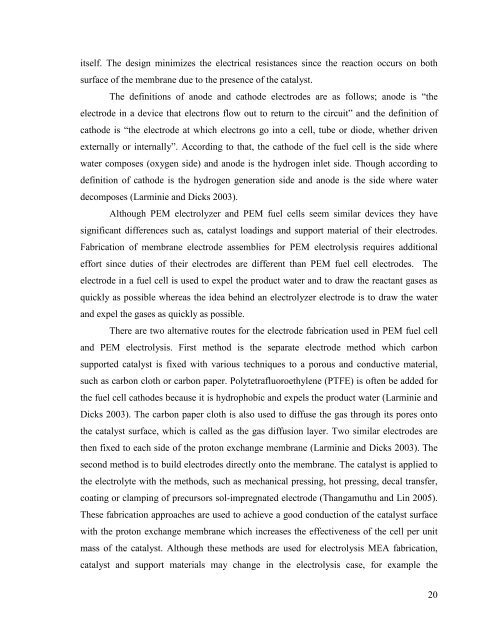hydrogen production from water using solar cells powered nafion ...
hydrogen production from water using solar cells powered nafion ...
hydrogen production from water using solar cells powered nafion ...
You also want an ePaper? Increase the reach of your titles
YUMPU automatically turns print PDFs into web optimized ePapers that Google loves.
itself. The design minimizes the electrical resistances since the reaction occurs on both<br />
surface of the membrane due to the presence of the catalyst.<br />
The definitions of anode and cathode electrodes are as follows; anode is “the<br />
electrode in a device that electrons flow out to return to the circuit” and the definition of<br />
cathode is “the electrode at which electrons go into a cell, tube or diode, whether driven<br />
externally or internally”. According to that, the cathode of the fuel cell is the side where<br />
<strong>water</strong> composes (oxygen side) and anode is the <strong>hydrogen</strong> inlet side. Though according to<br />
definition of cathode is the <strong>hydrogen</strong> generation side and anode is the side where <strong>water</strong><br />
decomposes (Larminie and Dicks 2003).<br />
Although PEM electrolyzer and PEM fuel <strong>cells</strong> seem similar devices they have<br />
significant differences such as, catalyst loadings and support material of their electrodes.<br />
Fabrication of membrane electrode assemblies for PEM electrolysis requires additional<br />
effort since duties of their electrodes are different than PEM fuel cell electrodes. The<br />
electrode in a fuel cell is used to expel the product <strong>water</strong> and to draw the reactant gases as<br />
quickly as possible whereas the idea behind an electrolyzer electrode is to draw the <strong>water</strong><br />
and expel the gases as quickly as possible.<br />
There are two alternative routes for the electrode fabrication used in PEM fuel cell<br />
and PEM electrolysis. First method is the separate electrode method which carbon<br />
supported catalyst is fixed with various techniques to a porous and conductive material,<br />
such as carbon cloth or carbon paper. Polytetrafluoroethylene (PTFE) is often be added for<br />
the fuel cell cathodes because it is hydrophobic and expels the product <strong>water</strong> (Larminie and<br />
Dicks 2003). The carbon paper cloth is also used to diffuse the gas through its pores onto<br />
the catalyst surface, which is called as the gas diffusion layer. Two similar electrodes are<br />
then fixed to each side of the proton exchange membrane (Larminie and Dicks 2003). The<br />
second method is to build electrodes directly onto the membrane. The catalyst is applied to<br />
the electrolyte with the methods, such as mechanical pressing, hot pressing, decal transfer,<br />
coating or clamping of precursors sol-impregnated electrode (Thangamuthu and Lin 2005).<br />
These fabrication approaches are used to achieve a good conduction of the catalyst surface<br />
with the proton exchange membrane which increases the effectiveness of the cell per unit<br />
mass of the catalyst. Although these methods are used for electrolysis MEA fabrication,<br />
catalyst and support materials may change in the electrolysis case, for example the<br />
20

















